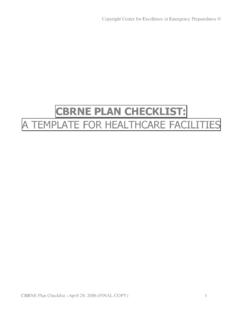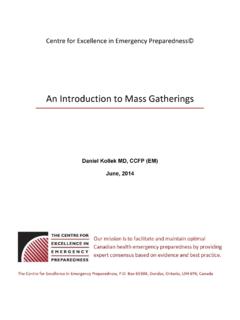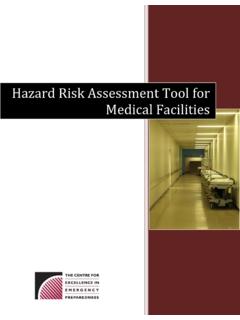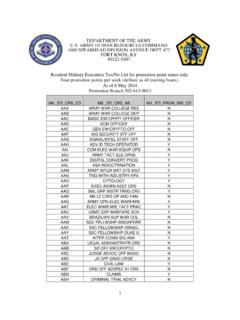Transcription of CBRNE Plan Checklist - The Centre for Excellence in ...
1 CBRNE plan Checklist i Preface Directions for the use of this tool are the same as outlined in the General Planning and Readiness Tool. Assessment items should be answered as follows: Y = yes; N = No; N/A = Not applicable; U= Unsure (for every U , the Facility must identify someone who will clarify the response). In some cases numerical information was felt to be more useful. The majority of the questions are in the Yes/No/Not Applicable (N/A) format. While it is assumed that a yes answer means the issue raised by the question has been addressed, the converse is not true. A No or N/A answer may mean that the Facility has a gap in its readiness or it may be that the answer was a product of an active decision. This document is not meant to be proscriptive but rather one that is thought-provoking and generates discussion. In making CBRNE preparations, facilities must consider key assumptions regarding communication, resources, and victims. When developing plans, facilities should anticipate: * Victims will arrive with little or no warning to the facility.
2 * Information regarding the hazardous agent(s) will not be available immediately. * A large number of victims will be self-referred (as many as 80 percent of the total number of victims). * Victims will not necessarily have been decontaminated prior to arriving at the facility. * A high percentage of people arriving at the facility will have little or no actual exposure and this eventuality should be considered in decontamination plans. * Most victims will go to the healthcare facility closest to the site where the emergency occurred. * Victims will attempt to use other entrances in addition to the emergency department (ED). ii Acknowledgements The Centre for Excellence in Emergency Preparedness wishes to acknowledge the following authors and significant contributors in the creation of this tool. Daniel Kollek , ( )1 Brian Schwartz , ( ), Daniel Cass , Bonnie Henry , , ; Eva Frances Gudgin Dickson , John Lindsay MCP6 Karen Wanger , , Ken Close8 H.
3 Roslyn Devlin, MHSc, MD, FRCP9 1 Associate Professor - Emergency Medicine, McMaster University; Executive Director - Centre for Excellence in Emergency Preparedness. 2 Associate Professor, Department of Family and Community Medicine, University of Toronto 3 Regional Supervising Coroner for Toronto West. 4 Director, Public Health Emergency Management and Physician Epidemiologist, British Columbia Centre for Disease Control; Assistant Professor Department of Health Care and Epidemiology, University of British Columbia. 5 Adjunct Associate Professor Department of Chemistry and Chemical Engineering and Defence Scientist. 6 Disaster Management Specialist, Manitoba Health; Assistant Professor and Chair Department of Applied Disaster and Emergency Studies. 7 Medical Director, Lower Mainland Region, British Columbia Ambulance Service; Clinical Associate Professor Faculty of Medicine, University of British Columbia. 8 Program Consultant Ministry of Health and Long Term Care Emergency Management.
4 9 Medical Director, Microbiology Laboratory and Infection Prevention and Control St. Michael s Hospital, Toronto All documents are the properties of the Centre for Excellence in Emergency Preparedness (CEEP) 2009. Users may freely use all CEEP material, provided that: (a) materials are not modified unless such changes are identified as not being part of the original CEEP document; and (b) users wishing to use this material in a for profit context must obtain prior permission from CEEP. iii The Process of developing this document was as follows: 1. Needs assessment/identifying the absence of a Canadian Healthcare Facility tool for readiness (2003). 2. Literature search (2004). 3. First draft (2004). 4. First draft reviewed and compilation of feedback (2004). 5. Second literature review and extraction of relevant documents (2005). 6. Panel review of literature search results and of edited initial tool (2006). 7. Compilation of panel s feedback and final draft (2006).
5 8. Final draft review by the panel (2006). Financial support for the development process of this document was received from Sunnybrook and Women s College Health Sciences Centre (Toronto), St. Michael s Hospital (Toronto), and the Public Health Association of Canada as grants. The National Framework for Health Emergency Management (NFHEM) was prepared by F/P/T Network on Emergency Preparedness and Response with the support of the Centre for Emergency Preparedness and Response (Health Canada / Public Health Agency of Canada) in 2004. Its goal is to set principles and elements of a comprehensive integrated framework that will provide a context for leadership and coordination through Federal/Provincial/Territorial emergency management systems in the health and social services sectors (F/P/T Network 2004 ). This General Readiness Checklist is part of a larger strategy to develop emergency management tools and processes consistent with the NFHEM s principles and provides a means to achieving several of its elements.
6 Iv Definitions CBRNE : A chemical, biological, radiological, nuclear or explosive event. Dirty Bomb: A mix of explosives, such as dynamite, with radioactive powder or pellets. When the dynamite or other explosives are set off, the blast carries radioactive material into the surrounding area. ( ) Incident Command System (ICS) or Incident Management System (IMS): A command and control system used by military, fire fighters and other agencies to manage critical incidents such as large fires or natural disasters. Hospital Emergency Incident Command System: The ICS as adapted to hospitals. This is sometimes abbreviated HEICS. Nuclear Incident: An incident whereby individuals are exposed to or contaminated with nuclear material. Also used to describe the detonation of a nuclear device. Radiological Incident: An incident whereby individuals are exposed to ionizing radiation, not exposed to or contaminated with nuclear material itself.
7 Surge Capacity: The ability to quickly and with little warning, increase the capacity to respond to an incident; in the case of healthcare facilities this refers to increase in capacity to care for patients. Internal Disaster: An event occurring within a facility affecting the ability of the facility to provide care to its usual capacity. External Disaster: An event occurring outside the facility that overwhelms the capacity of the facility to safely care for victims. v Table of Contents Preface .. i Acknowledgements .. ii Definitions .. iv Section 1: Foundational Considerations .. 1 Section 2: Planning .. 2 Section 3: Training and 3 Section 4: Procedures .. 4 Section 5: Module for Preparing for a Biological Incident .. 7 Section 6: Module for Preparing for a Chemical Incident .. 12 Section 7: Module for a Radiological or Nuclear Incident .. 15 Appendix 18 References .. 20 vi CBRNE plan Checklist A Template for Healthcare Facilities Name of Healthcare Facility: _____ Facility Address: _____ _____ Name and Title of Person(s) Completing Form: _____ _____ _____ Contact Information: Phone: ( _) _____ Pager: (___) _____ Fax: (___) _____ Email: _____ Sections Person(s) Responsible Section 1: Foundational Considerations Section 2: Planning Section 3: Training and Awareness Section 4: Procedures Section 5: Module for Preparing for a Biological Incident Section 6: Module for Preparing for a Chemical Incident Section 7: Module for a Radiological or Nuclear Incident 1 Section 1: Foundational Considerations (See also Chapter 3 - Readiness & Mitigation Part 1: General Planning and Readiness Tool) Person Responsible for Completing Section 1.
8 _____ Yes No N/A U Required Action (s) Person Responsible Has a risk assessment been performed that specifically considers CBRNE incidents? Does the facility disaster plan include specific consideration of CBRNE incidents? Is there a CBRNE planning committee? Is there currently a collaborative relationship with the local Emergency Response Agencies and Public Health regarding CBRNE incidents? Does the plan detail actions to be taken for both internal and external disasters? Does the CBRNE plan detail how it links with local Emergency Response Agencies? Is the plan widely distributed and readily available throughout the hospital/healthcare facility? (Distribution should include hard copies of the plan and an automated method that is readily available to all staff members) Does your hospital s CBRNE preparedness plan address requesting appropriate local, provincial, or federal resources for assistance?
9 Does the plan specify the number and location of isolation or protective environment rooms? Are these locations clearly identified in a document readily available to the disaster coordinator or command team? Are isolation facilities monitored to ensure adequate airflow? 2 Section 2: Planning Person Responsible for Completing Section 2: _____ Yes No N/A U Required Action (s) Person Responsible Does your facility have a coordinator designated to oversee all CBRNE preparedness efforts? Does your facility have a medical director who oversees all training and preparedness efforts as it relates to your facility s CBRNE preparedness efforts? 3 Section 3: Training and Awareness Person Responsible for Completing Section 3: _____ Yes No N/A U Required Action (s) Person Responsible Does every person working in your facility know how to identify signs and symptoms of exposure to CBRNE agents?
10 Does every person working in the facility know whom to contact internally upon identification of exposure/symptoms related to CBRNE agents? Is there specific ongoing training for personnel assigned to the facility s CBRN response? Does your facility plan include identification of roles and responsibilities specific to a CBRN event, to include: Security Identification, chain of custody, and storage of contaminated items Analysis of contaminated specimens Transport of contaminated items Transport of contaminated deceased persons Triage personnel Decontamination team Patient care teams Does your facility s plan identify positions/individuals to fill roles/responsibilities required for CBRNE response? Does every person who is part of the CBRNE response team know where the equipment is/how to access it? Have all members of the CBRNE response team including Emergency Department (ED) personnel been trained in CBRNE Preparedness?













